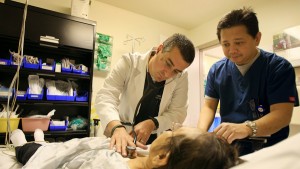“We have room for improvement, but that’s why we do validation so providers can … improve the quality of the data,” said Debby Rogers, deputy director of the Center for Health Quality at the Department of Public Health.
The reviews, completed last year, consisted of one- to two-day examinations by public health authorities at 100 hospitals that volunteered; there are more than 400 hospitals in the state. Reviewers examined infection data that was reported in 2011 and compared that with medical lab findings and patient records. Results for individual hospitals were not tracked.
Reviewers took a close look at hospital reporting practices of infections including VRE, or vancomycin-resistant enterococci, C. Dif., or Clostridium difficile, and MRSA, or methicillin-resistant Staphylococcus aureus. Each of those germs can be difficult to treat with conventional medicines. They can also be deadly to fragile or elderly people in hospitals.
Reviewers also looked at infections related to central lines, which are catheters implanted in a vein near the heart of a patient to deliver needed fluids. In worst-case situations, they can deliver germs that trigger sepsis, or bodywide infections spread through the bloodstream.
Reviewers found that hospitals failed to report about one-fourth, or 150 out of 577 C. difficile infections. Among central-line infections, hospitals missed reporting more than a third, or 68 out of 180 verified infections.
For VRE, hospitals also missed about a quarter of the 149 reportable cases, and for C. Dif, hospitals missed nearly 10 percent of 2,338 reportable cases.
Underreporting was often a result of confusion about complex instructions on identifying which infections were caused by hospital practices.
Yesterday, the department released updated data detailing 2011 health care-associated infections throughout the state. An interactive map shows the rates of infections at hospitals throughout the state but does not explain whether the numbers were double-checked by state authorities.
Dave Perrott, chief medical officer for the California Hospital Association, said a major component in improving reporting will be updated computer systems that keep data to pinpoint when, where and how infections appear.
Overall, he said the review helped clarify the definition of each hospital-acquired infection, meaning hospitals can identify a baseline of how many infections they’re seeing.
“I think benchmarking gives a chance to make improvements,” Perrott said. “It’s like when you ride a bike for the first time, you’re going to have training wheels, there’s going to be a few falls. As we go on it gets better.”
California performed the review of infection reporting with federal stimulus funds from the Centers for Disease Control and Prevention. While ongoing reviews are not expected, Rogers said the state recently got additional funding to review reports of surgical-site infections.
Julia Hallisy, a San Francisco dentist and president of the Empowered Patient Coalition, said the extent of the underreporting is troubling.
“This shows there are issues with educating the hospitals, and it shows why surveillance is important,” said Hallisy, who said her daughter was disabled by a hospital-acquired infection.
Lisa McGiffert, director of the Consumers Union Safe Patient Project, said the infection reporting program in California is funded by fees levied on hospitals that should include money to continuously double-check the data.
“If (hospitals are) not reporting accurate data, then this is a necessary part of the program,” she said.
Other states have also performed extensive reviews and found unreported infections. Colorado authorities found that 34 percent of central-line infections that should have been reported by hospitals were not, according to a state report.
In Connecticut, researchers concluded that about half of the central-line infections that should have been reported were missed.
New York authorities routinely double-check the central-line reports by hospitals and appear to have a worse – but perhaps more accurate – rate of such infections compared the national average.
McGiffert said the CDC has issued reports showing apparent national declines in 2010 of central-line infections. However, she said the repeated findings of underreporting by states call for a closer look before conclusions are reached.
“The CDC says the rates are going down significantly – let’s be sure that’s really happening,” she said.
